

Choosing a Vice President
Nomination of the vice presidential candidate occurs at the party's national convention. The convention delegates usually nominate the person preferred by the presidential nominee. A contest develops only if the presidential nominee makes no choice. The vice presidential candidate is often called the presidential nominee's running mate.
Many factors may influence the selection of a vice presidential nominee. After a bitter campaign for the presidential nomination, the nominee may want a running mate who can help restore party harmony. The choice for Vice President may be one of the losing candidates for the presidential nomination, or a supporter of one of the losers. In 1844, the Democrats nominated Senator Silas Wright of New York for Vice President. They did this to appease former President Martin Van Buren, who had failed to win the Democratic presidential nomination. But Wright, a close friend of Van Buren, refused. In 1972, the Democratic vice presidential nominee, Senator Thomas F. Eagleton, became the only person ever to withdraw after having accepted a party's nomination at a national convention. He did so following the disclosure that he had received psychiatric treatment.
Often the Vice President comes from one of the states considered to be especially important in the election. This may be a state in which the election outcome is expected to be very close, or it may simply be a state with a large electoral vote. By appealing to local loyalties, the vice presidential candidate may strengthen the party's vote in this “home” state.
Sometimes the vice presidential candidate is chosen because the person is thought to appeal to a large bloc of voters. In 1984, the Democrats nominated Representative Geraldine A. Ferraro of New York for Vice President. She was the first woman and the first person of Italian descent ever chosen as the vice presidential candidate by a major American political party.
The vice presidential choice often is made to balance the ticket. If an older candidate is nominated for President, a younger person may be chosen for Vice President. A presidential nominee from the East may be balanced with a vice presidential nominee from the West. If the presidential nominee is known as a conservative, the vice presidential nominee may be a liberal. By balancing the ticket, party leaders hope to win the support of the largest possible number of voters.
The system of selecting a Vice President helps the party win the election. It does not necessarily produce the person best qualified to serve as Vice President. The custom of balancing the ticket with people of conflicting political beliefs has often been criticized. Theodore Roosevelt said early in his political career: “It is an unhealthy thing to have a Vice President and President represented by principles so far apart that the succession of one to the place of the other means a change as radical as any party overturn.” This occurred when John Tyler succeeded William Henry Harrison and when Roosevelt later succeeded William McKinley.
The campaign
The vice presidential candidate plays an active role in the election campaign. The vice presidential and presidential candidates usually map out separate campaign routes for maximum coverage of the country. They may later change places to cover all strategic areas with repeated campaigning.
Election
Voters select the same electors for the Vice President when they choose presidential electors. They cannot split the ticket. That is, a person cannot vote for electors of the presidential candidate of the Republican Party and for electors of the vice presidential candidate of the Democratic Party. Citizens must vote for a slate of electors pledged to one party's candidates.
The Electoral College elects the President and Vice President on separate ballots. If the Electoral College fails to choose the Vice President by a majority vote, the Senate elects one of the two leading candidates. At least two-thirds of the Senate must be present at the voting, and the winner must receive a majority vote of the entire membership.
The Senate has elected a Vice President only once. In 1837, the Senate elected Richard M. Johnson, a Democrat, by a vote of 33 to 16 over Francis Granger, a Whig. Johnson had fallen one vote short in the Electoral College. He became so controversial that the Democrats refused to renominate him in 1840. In fact, they failed to nominate any vice presidential candidate--the only time any convention has done so.
Inauguration
Until 1933, the Vice President took the oath of office in the Senate. Today, both President and Vice President are inaugurated in the same ceremony in January after their election. The Vice President is sworn into office immediately before the President is inaugurated. The Vice President's oath may be administered by the retiring Vice President, by a member of Congress, or by some other government official, such as a justice of the Supreme Court. In the early days, the Vice President made an inaugural address. This custom has disappeared with the adoption of the combined ceremony in which the President gives the inaugural address.
The 25th Amendment spells out procedures for filling a vacancy in the vice presidency. The office becomes vacant if the Vice President dies, resigns, or is unable to carry out the duties of office. Then the President appoints a new Vice President. The appointment is subject to the approval of a majority of both the Senate and the House of Representatives. In 1973, House Minority Leader Gerald R. Ford became the first Vice President chosen under the terms of the 25th Amendment. Ford succeeded Vice President Spiro T. Agnew, who resigned.
A List of the Vice Presidents | Roles of the Vice President>>







